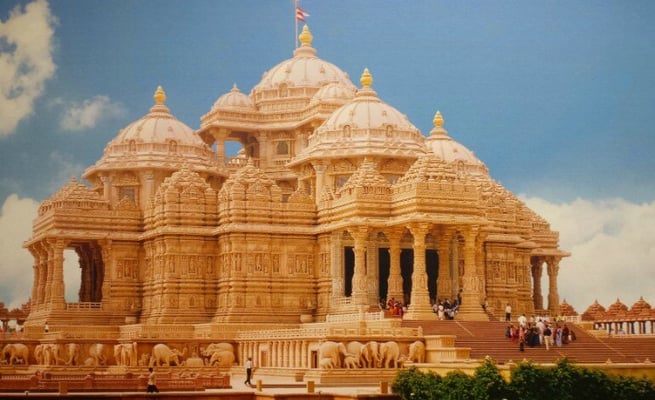Scientific reasons for visiting temples

Visiting temples is customary for most Hindus. It is ingrained in our lifestyle. In India, prolific temple building started more than 2,500 years ago. In South India alone, there are more than 108,000 temples. Visiting temples is not just to get divine blessings and to find peace; there are several other benefits, too.
The location and structure
Temples are built on vaasthu principles at a place where positive energy is available abundantly from the magnetic and electric waves of north and south poles. The idol of the deity is set in the sanctum sanctorum of the temple known as garbhagriha or moolasthanam where the Earth’s magnetic waves are extreme.
Walking barefoot inside the temple
Temples are known to project pure vibrations of magnetic and electric fields with positive energy. In the olden days, temples were built with stone floors. Devotees walked barefoot inside the temple so their bodies could absorb the positive vibrations from the temple through their feet.
Activation of the senses
There are several benefits and meanings for the various rituals conducted in temples.
Not only are the rituals established to offer prayers to the Almighty but it also specifically activates the various senses or indriyas in the body.
Ringing the bell
Before entering the moolasthanam, where the main idol is placed, the ringing of the brass bell produces a sound that creates unity in the left and right parts of the brain. The loud and high-pitched sound reverberates for a minimum of seven seconds. This sound is known to activate the seven fundamental or healing chakras in the body. The sound of the bell dispels negative thoughts from the human mind and is absorbed by the idol and vibrated for a certain amount of time.
Lighting of camphor
The moolasthanam of ancient temples is often dark. You usually close your eyes to pray and when you open your eyes, you can see the camphor that was lit during the aarthi. The bright light of the burning camphor seen in the dark surrounding activates the sense of sight. The idol also absorbs the heat and sharp aroma of the camphor flame.
Taking aarthi
The priest brings the camphor to the devotees after the aarthi. You then take the deity’s blessings by placing your hands gently over the camphor. This makes your hands warm and then you touch your eyes. This activates your sense of touch.
Offering flowers to the deity
Flowers produce a beautiful fragrance and are soft to touch. Only specific flowers are used for puja such as rose petals, jasmine, and marigold based on different factors, but the most important one is fragrance. The combined fragrance of the flower, camphor, and incense sticks has the strong essence to activate your sense of smell and also calm the mind.
Drinking theertham
The water used for theertham would usually contain tulsi leaves dipped in water and must be stored in a silver or a copper vessel. According to Ayurveda, water stored in a copper vessel has the ability to balance all the three doshas in your body and does so by positively charging the water. By drinking theertham, the sense of taste is activated. Theertham is believed to cure sore throat, cold, cough, and respiratory problems as well as reduce the formation of kidney stones.
Doing pradakshina
After performing all the rituals, you have to walk around the idol in a clockwise direction for nine times. Pradakshina literary means the right side in Sanskrit.
The idol of the deity inside the garbhagriha absorbs all the energy from the rituals and radiates positive energy. When you do the pradakshina, you tend to absorb all these positive vibrations once the five senses are activated. It is advised to visit the temples often and follow the same rituals to get prolonged benefits to the body and mind.
Use of kumkum and tilak
Our scriptures tell us that the spot between the eyebrows has to be protected with a tilak or kumkum, as this is a major nerve point. This helps to retain energy in the human body and control the various levels of concentration. While applying kumkum, the points on the mid-brow region and adnya-chakra are automatically pressed. This also facilitates the blood supply to the face muscles.
Offerings to the deity
It is recommended to use only bananas and coconuts during puja. These are considered pure and untainted, as they do not grow from seeds. The coconut tree grows from the sapling from a full coconut and the banana tree grows from an offshoot from the roots of the main tree. This is the reason why coconut and banana have an important place in all religious activities. Our ancestors had discovered these thousands of years ago and this system is still followed today.
Visiting temples is customary for most Hindus. It is ingrained in our lifestyle. In India, prolific temple building started more than 2,500 years ago. In South India alone, there are more than 108,000 temples. Visiting temples is not just to get divine blessings and to find peace; there are several...
Visiting temples is customary for most Hindus. It is ingrained in our lifestyle. In India, prolific temple building started more than 2,500 years ago. In South India alone, there are more than 108,000 temples. Visiting temples is not just to get divine blessings and to find peace; there are several other benefits, too.
The location and structure
Temples are built on vaasthu principles at a place where positive energy is available abundantly from the magnetic and electric waves of north and south poles. The idol of the deity is set in the sanctum sanctorum of the temple known as garbhagriha or moolasthanam where the Earth’s magnetic waves are extreme.
Walking barefoot inside the temple
Temples are known to project pure vibrations of magnetic and electric fields with positive energy. In the olden days, temples were built with stone floors. Devotees walked barefoot inside the temple so their bodies could absorb the positive vibrations from the temple through their feet.
Activation of the senses
There are several benefits and meanings for the various rituals conducted in temples.
Not only are the rituals established to offer prayers to the Almighty but it also specifically activates the various senses or indriyas in the body.
Ringing the bell
Before entering the moolasthanam, where the main idol is placed, the ringing of the brass bell produces a sound that creates unity in the left and right parts of the brain. The loud and high-pitched sound reverberates for a minimum of seven seconds. This sound is known to activate the seven fundamental or healing chakras in the body. The sound of the bell dispels negative thoughts from the human mind and is absorbed by the idol and vibrated for a certain amount of time.
Lighting of camphor
The moolasthanam of ancient temples is often dark. You usually close your eyes to pray and when you open your eyes, you can see the camphor that was lit during the aarthi. The bright light of the burning camphor seen in the dark surrounding activates the sense of sight. The idol also absorbs the heat and sharp aroma of the camphor flame.
Taking aarthi
The priest brings the camphor to the devotees after the aarthi. You then take the deity’s blessings by placing your hands gently over the camphor. This makes your hands warm and then you touch your eyes. This activates your sense of touch.
Offering flowers to the deity
Flowers produce a beautiful fragrance and are soft to touch. Only specific flowers are used for puja such as rose petals, jasmine, and marigold based on different factors, but the most important one is fragrance. The combined fragrance of the flower, camphor, and incense sticks has the strong essence to activate your sense of smell and also calm the mind.
Drinking theertham
The water used for theertham would usually contain tulsi leaves dipped in water and must be stored in a silver or a copper vessel. According to Ayurveda, water stored in a copper vessel has the ability to balance all the three doshas in your body and does so by positively charging the water. By drinking theertham, the sense of taste is activated. Theertham is believed to cure sore throat, cold, cough, and respiratory problems as well as reduce the formation of kidney stones.
Doing pradakshina
After performing all the rituals, you have to walk around the idol in a clockwise direction for nine times. Pradakshina literary means the right side in Sanskrit.
The idol of the deity inside the garbhagriha absorbs all the energy from the rituals and radiates positive energy. When you do the pradakshina, you tend to absorb all these positive vibrations once the five senses are activated. It is advised to visit the temples often and follow the same rituals to get prolonged benefits to the body and mind.
Use of kumkum and tilak
Our scriptures tell us that the spot between the eyebrows has to be protected with a tilak or kumkum, as this is a major nerve point. This helps to retain energy in the human body and control the various levels of concentration. While applying kumkum, the points on the mid-brow region and adnya-chakra are automatically pressed. This also facilitates the blood supply to the face muscles.
Offerings to the deity
It is recommended to use only bananas and coconuts during puja. These are considered pure and untainted, as they do not grow from seeds. The coconut tree grows from the sapling from a full coconut and the banana tree grows from an offshoot from the roots of the main tree. This is the reason why coconut and banana have an important place in all religious activities. Our ancestors had discovered these thousands of years ago and this system is still followed today.









Leave a Comment